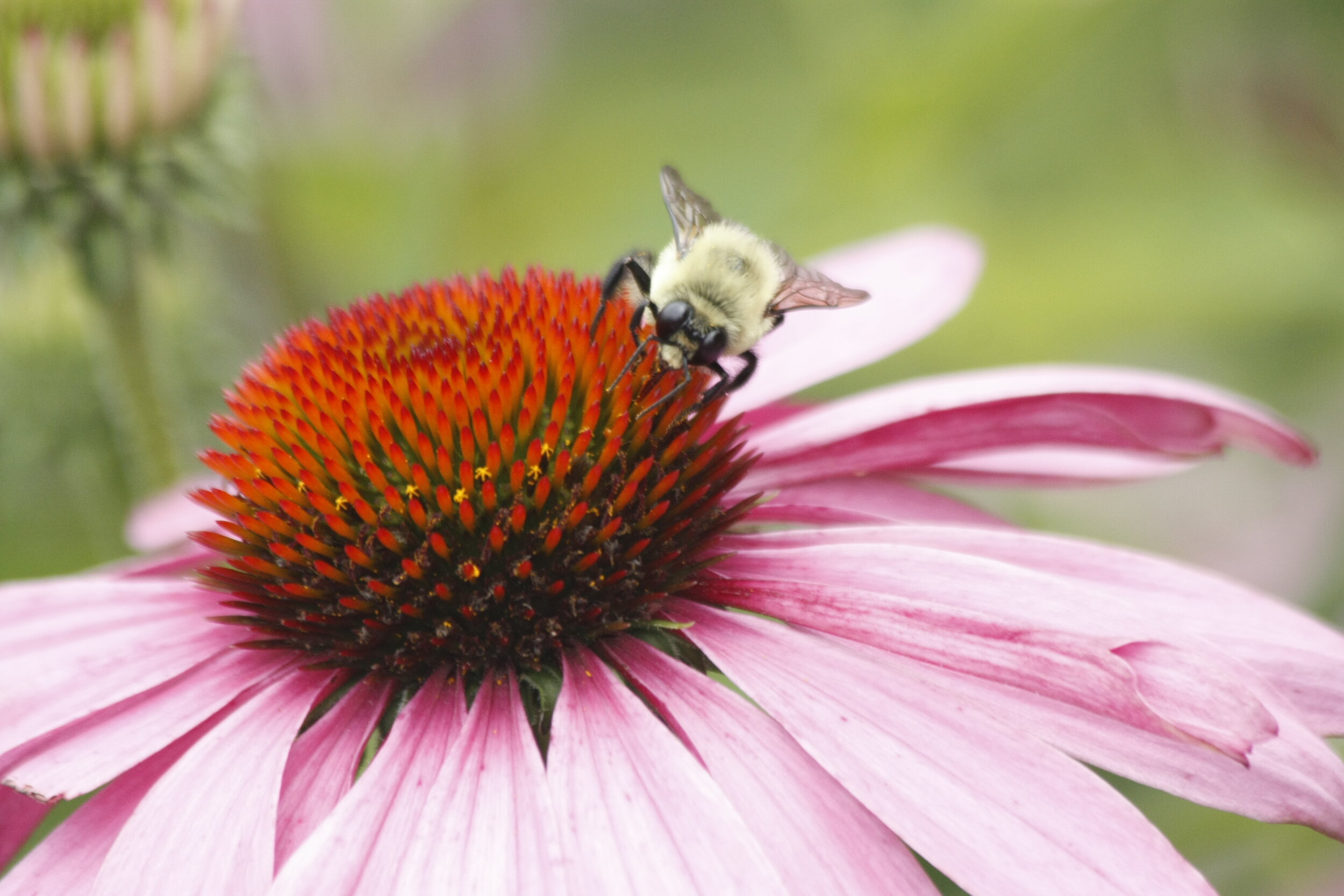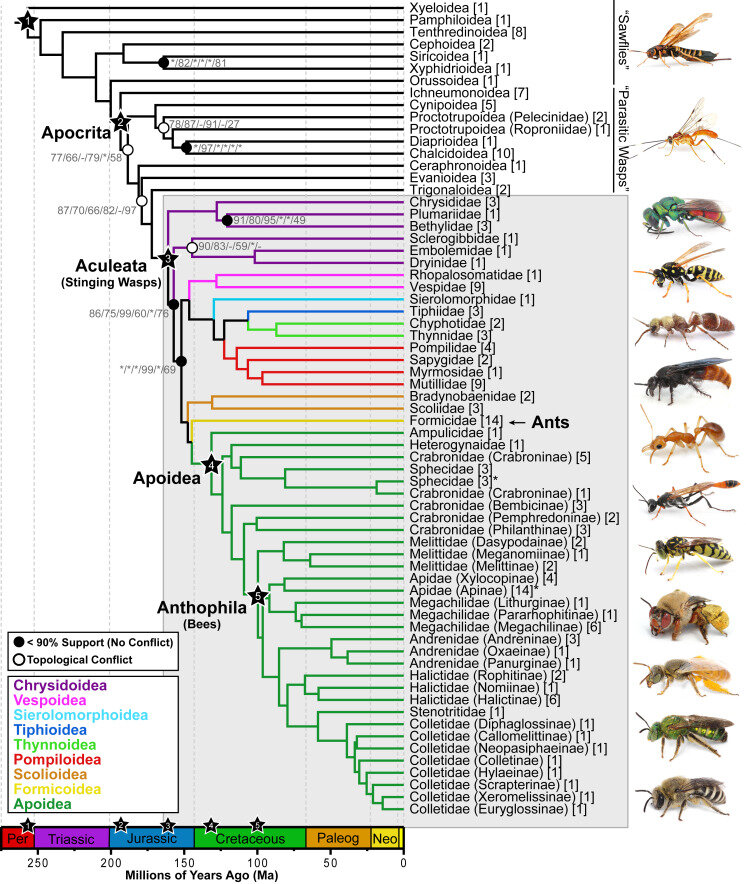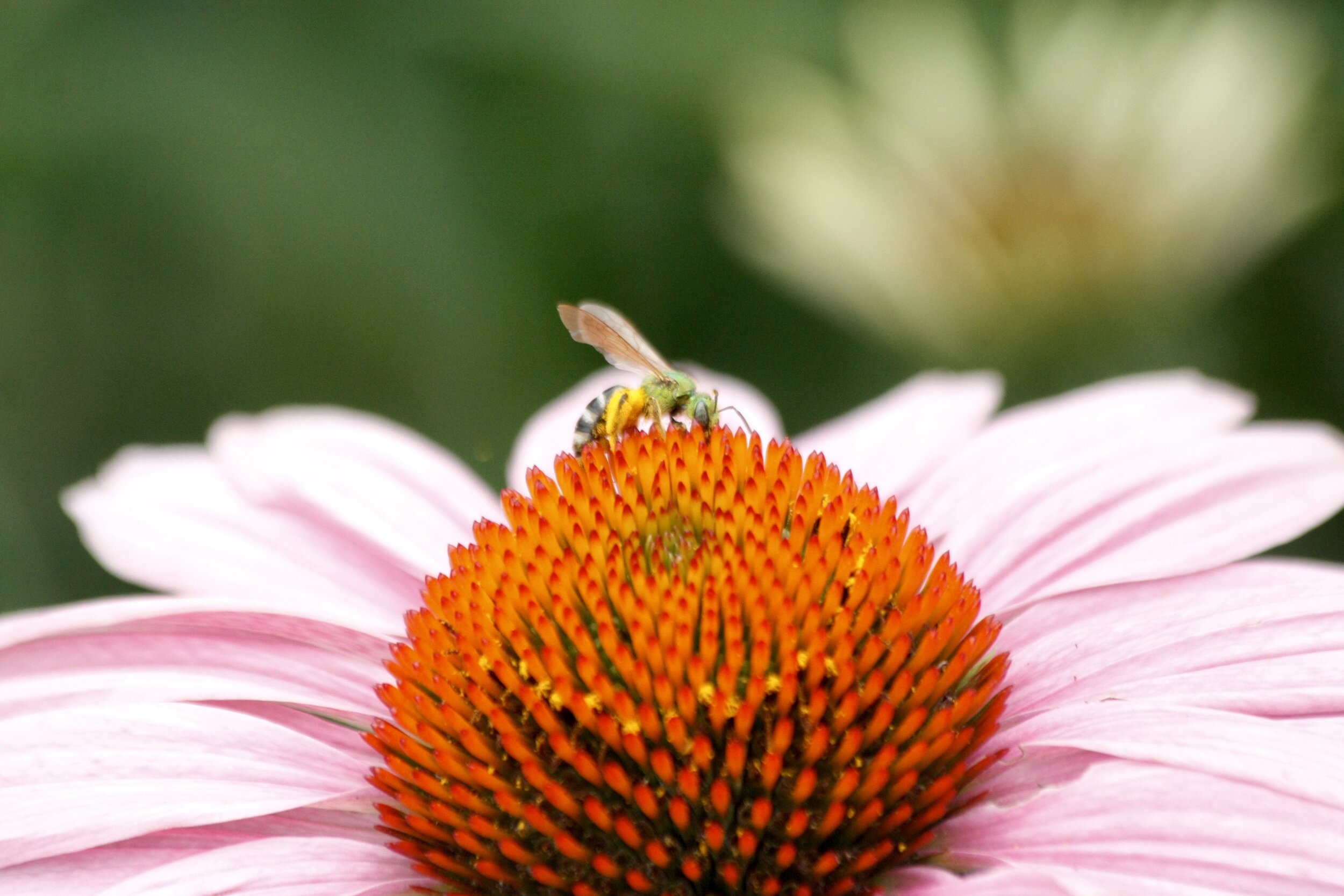Local Wildlife Weekly #4: Bees!
/This is part of the 2020 Digital Seaside Center. For more Digital Seaside Center content, click here.
Hello everyone!
I am departing a bit from my model this week, as the title of this post suggests: this is not a profile of a single species. This is not even a profile of a single genus. This is… complicated. With there being over 300 bee species in Connecticut, this shift in scope is vast and consequential— I can explain!
Two weeks back I wrote about a unique species of dragonfly, the seaside dragonlet. While odonate diversity in the state is comparable to winged hymenopteran (bee and wasp) diversity, I engage with these diversities in strikingly different ways. I have been observing and identifying dragonflies for several years now, and generally know the group on a species-by-species basis (as I also do with butterflies and moths). Dragonflies have a small but committed fanbase of causal observers, and excellent field guides exist to aid in their field identification. They are a challenging group, but the resources are there to help. The same can not be said for bees: they remain, for the most part, a field identification frontier. As a result I tend to pass them over in the field, not even bothering to try. They are abundant and share many characteristics with the flying insects I focus on, yet still I keep my distance. I realize this seems… wrong.
I wrote this concerning the dragonlet:
“I only started looking at odonates a few years ago, long after developing an interest and eye for birds, reptiles, fish, etc. To think of the little wonders I was missing out on all that time! I would never know to marvel, or look closely, at organisms like the seaside dragonlet if I didn’t recognize the unusual characteristics of their ecology, and this comparative aspect comes with experience and education. It remains a great reminder of the doors that nature education can open, and just how transformative it can be.”
Oh, the hypocrisy! Why am I letting ID resources dictate where I direct my wonder? The fact that I look at dragonflies instead of bees isn’t because I prefer the former to the latter— rooted in expediency, it all seems a bit arbitrary. Think of all the little wonders I’m still missing out on! I need to take my own advice; it’s never too late to right a wrong.
With this in mind, I spent some time this week looking at bees. I know little about these insects, so this period of observation was one of child-like wonder, freed from the blinders of preconception. For this post I thought I’d walk readers through the process of observation, describing what I saw and learned from one peer to another. If you want to learn more about the natural history of bees, Science Curatorial Assistant and Seaside Center Manager Kate Dzikiewicz has written about it twice before on this blog. You can find those posts here and here. They can provide an excellent foundation for some of the topics I’ll touch on in this post. Let’s get exploring!
Photo by Brendan Murtha
Introducing: Bees!
I don’t have a particularly vibrant garden in my backyard, unfortunately, so to observe bees I went down to a beautiful plot of flowerbeds aside the Five-Mile River in Norwalk, near where I live. I was not disappointed. The coneflowers and yarrow were thrumming with activity, with insects coming and going everywhere I looked. The closer I leaned in to any one clump of flowers, the more I saw: such is the joy of looking for insects. Staggering diversity can be sampled within tiny amounts of space. They say an entomologist could walk out their door in the morning, with the goal of identifying every insect they saw, and make it five feet by sundown.
The first bees I noticed, loud and large and cumbersome, were bumblebees. Surprise, surprise! Bumblebees are often the hook for people’s interest in bees, for they’re generally obvious and easy to observe. Even if you intend to move beyond them (some people are perfectly content to watch bumblebees forever) this group is a good place to start. The category “bumblebee” sounds like a crude colloquialism, but it actually maps neatly onto recognized taxonomy: it refers to members of the genus Bombus (one of my favorite Latin names). “Bombus-bees” sounds suspiciously like “bumble-bees,” a good way to remember the former: Bombus is derived from the Latin word bómbos, a buzzing or humming sound. The similarity is perhaps not entirely coincidental!
Bombus are immediately recognizable by their size and “fuzzy” appearance, and most are decked out in the classic black/yellow color-scheme we associate with bees. However, as I looked over the bumblebees in this garden, I noticed they did not all look the same. Some bumblebees were smaller than others, and the patterning on their abdomens was not consistent. I recognized Bombus impatiens, the common eastern bumblebee, with its predominantly black abdomen and clear wings— but what was the other one? The smaller Bombus had dark wings and a strip of browned, stained yellow on the abdomen.
I used the wonderful app iNaturalist (which I would highly recommend) and some online resources (will link below) to come up with an ID: brown-belted bumble bee, Bombus griseocollis. Cool! I had never heard of this species before, even though it’s apparently quite common in the Northeastern U.S. What was I saying earlier about missing the little wonders?
A common eastern bumble bee, Bomus impatiens. Photo by Brendan Murtha.
A brown-belted bumble bee, Bombus griseocollis.
Watching both species of Bombus buzz around from flower to flower, I was charmed by their awkward sloppiness. These bees feed on nectar, and extract it with a long tongue-like proboscis— a behavior you can observe in the field. The bumblebees I watched were lapping up nectar like cats or dogs at a food bowl, a familiar motion turned alien. Bees returned to the same flower, or patch of flowers, over and over again, while other flowers seemed arbitrarily neglected. I realized I was seeing floral constancy in action. Bees have a habit of learning which flowers are productive and returning to them exclusively, passing over many other suitable food-sources as they do. This behavior goes far beyond innate specialization or preference; it is an individualized, developed strategy. The routine likely saves foraging time and energy in the long run, as well as minimizing competition between individuals, but it does not guarantee that bees visit the most rewarding flowers— there are trade-offs at play. It’s a fascinating behavior being explored in a lot of contemporary research (I’ll link to some of it at the end of this post).
Slurrrp. See the proboscis? Photo by Brendan Murtha.
I also noticed that most of these bees had stocked “pollen baskets,” or corbiculae. These pockets in the tibia, surrounded by hairs, are where bees store the pollen they collect while foraging. Bumblebees, covered in fine hairs, pick up a dusting of pollen every time they visit a flower, and will actively “clean” themselves (also a somewhat mammalian act) by brushing this pollen into their corbiculae. The “baskets” can bulge with pollen after a few rounds of this, looking like packed holsters— this is all food the bees will bring back to the nest to rear young. Of course, not all pollen gets delivered home— bees are often covered in it, and pollen picked up on one flower often gets brushed off on another. This is an essential part of pollination. Observing this, I couldn’t help but wonder: is floral constancy deleterious to rates of pollination? If bees learn to visit the same flowers over and over, isn’t pollen transfer reduced?
After a bit of research, the answer now seems obvious: no. In fact, pollen transfer is aided by floral constancy. Bees don’t just visit the same individual flowers; their constancy is often extended to recognition of species. If a bee has a particularly productive visit to a lupine, it will then seek out other lupines at the expense of buttercups and lilies— bringing pollen from one individual plant to another of the same species. This way, pollen transfer is actually more efficient! If bees were to hop from flower to flower in a diverse meadow, not showing preference for species, successful fertilization would be rare, and pollinator-pollinated relationships might crumble.
See the corbiculae, filled with pollen? Photo by Brendan Murtha.
I could have watched the bumblebees all day. However, as I followed them from flower to flower, their paths crossed with other bees— bees I was less familiar with.
Growing up, I knew “bees” to come in two varieties: honeybees and bumblebees. Up until recently these vague categories remained the extent of my knowledge, even though most bee diversity falls outside their scope. I know I was not alone in this over-simplification. Bees are a staple in popular culture, but representation is one-sided: children’s books and media always depict bees in their standard blacks-and-yellows, very Bombus-centric. Few distinctions are drawn. Children learn early on that bees = honey, yet “honeybees” (european honey bee, Apis mellifera) are not really black-and-yellow, and Bombus don’t produce honey: this is all flipped on its head! This has especially been the case lately, it seems, as the crisis of colony collapse and bee decline has entered into mainstream dialogue. Bee representation today is often tailored to raise awareness of their plight and make the case for their ecological importance. There has been a bee renaissance, one could say, and I am not here to dismiss it— the issues it raises are important, and more bees are unequivocally better than less (even if representation is wrong, or skewed). Yet implicit in this framing is a utilitarian outlook towards bees: honeybees are the focus of this dialogue because they are commercially important, both on their own and through pollination of essential crops (let us not forget that the standard honeybee is itself an introduced species). While not wrong, per say, this focus is misplaced. Bees come in all shapes and sizes, and each plays an important role: because most bees aren’t widely recognizable as such, at least by current standards, they are left out of discussion. In the garden, I found a remarkable variety I had never taken time to appreciate before.
It’s perhaps useful to do a brief overview of hymenopteran phylogeny. This order, which I mentioned in the first paragraph of this post, includes bees, wasps, and ants. That’s right— ants are, by many definitions, just wingless wasps. We won’t go into detail here: you can get a sense of the chaos through the phylogenetic tree below. As with many groups of organisms, their evolutionary history is… complicated.
An excellent phylogeny of Hymenoptera. Source: Branstetter et al. 2017.
What we call “bees” are best represented as a clade, a group of organisms sharing a common ancestor (but not necessarily encompassed through the categories of family, genus, etc.) Worldwide there are 16,000 species recognized in this clade, Anthophila. The 250 species of Bombus thus make up just ~1.5% of bee species, and honeybees (Apis) comprise a much smaller percentage than that. Because the vast majority of bee imagery / education is based off of these two groups, you can see we have a representation problem on our hands.
This was evident in the garden. There were some Honeybees around, but they made up a small fraction of the Anthophila pollinators in the air.
European honey bee, Apis mellifera.
More common were Halictid bees, family Halictidae— this family makes up the largest slice of bee diversity in our area. Commonly called “sweat bees,” these bees are characterized by their small size and solitary, ground-nesting habits. They get their common name from a fondness for salty perspiration, although they more commonly feed on nectar. Halictids can be tiny, easily mistaken for flies, and although they do sting it’s rarely ever painful. On that note, many non-stinging flies mimic Halictid bees, so the confusion here only mounts— I suppose the Halictid sting is enough of a predator deterrent to warrant mimicry. Certain Halictid bees have pollen baskets, like Bombus or Apis, and engage in a similar ecology. Others are quite divergent. I have identified the following species as a ligated furrow bee, Halictus ligatus, but here we enter a realm where all my IDs are tentative. The resources for Halictid ID are few and far between, and there are still species out there poorly known to science. I suppose I’m coming around to why that’s so exciting.
A ligated furrow bee (I think), Halictus ligatus. Look at the pollen baskets on this one! Photo by Brendan Murtha.
You can see that this furrow bee resembles some familiar Bombus/Apis bees in its shape and patterning. However, it’s more closely related to other Halictids, like this wild looking bicolored striped sweat bee (Agapostemon virescens).
A bicolored striped sweat bee, Agapostemon virescens. Photo by Brendan Murtha.
This is the kind of local wildlife that really excites me. Look at that color scheme! It looks like something you’d see on a Star Wars alien— how was I not looking at Halictid bees before?
All these observations were made l in a single 12 x 12 garden plot, surrounded by manicured lawns in a heavily developed suburban area. It turns out that this is not all that crazy— around here, bee diversity can be higher in heavily gardened suburban areas than it is in natural habitats of the same dimensions. There is a fine line here, of course, and we shouldn’t take this as a green light for development: bees are just one part of a much larger picture. The increase is closely dependent on the gardens available, too— not all gardens are created equal. A wider diversity of plantings hosts a wider diversity of bees, and native plantings are best. But, as these photos hopefully illustrate, the payoff can be huge! And, as I’m learning, this only scratches the surface. There are mason bees, leafcutter bees, carpenter bees, cuckoo bees, etc… the list goes on.
As I poked around the garden, I kicked up a few butterflies and dragonflies I’m familiar with— I know their names and count them as old friends. I was happy to see them, but there was a bittersweet element: I could know bees that well, if only I had started earlier!
Oh well. Better late than never. For all readers who garden or simply enjoy walking through fields of flowers, I invite you to join me— lets learn our local bees together! I’m already itching to get back out and start looking for more.
Til next time!
Sources for Bee ID (and info):
https://www.inaturalist.org
https://www.discoverlife.org/20/q?search=Apoidea
For more info on floral constancy (and associated topics), check out the website of a Bowdoin professor (shameless plug of my school, and my advisor) who does awesome work in this field: http://www.patriciajones.org
- Brendan Murtha, 2020 Seaside Center Naturalist























